Tupua Tamasese
Tupua (known as Tupua Tamasese) is a state dynasty and one of the four paramount chiefly titles of Samoa,[1] known as the Tama-a-Aiga ('Sons of the Families'). It derives its name from the first Tupua - King Tupua Fuiavailili - who was descended from the royal line of Queen Salamasina (via Tapumanaia, her second child) and adopted to the elder line of her descendant, King Fonoti (who is descended from Fofoaivaoese, Salamasina's eldest child). Tupua ascended to become King of Samoa in c.1550, upon the death of his father, King Muagututi'a. .[2]
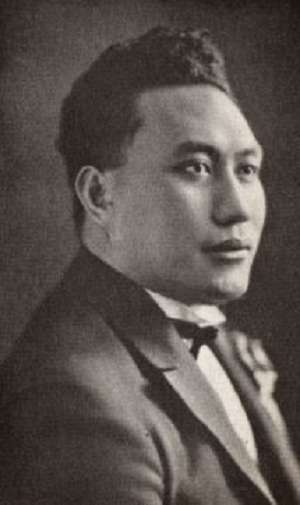
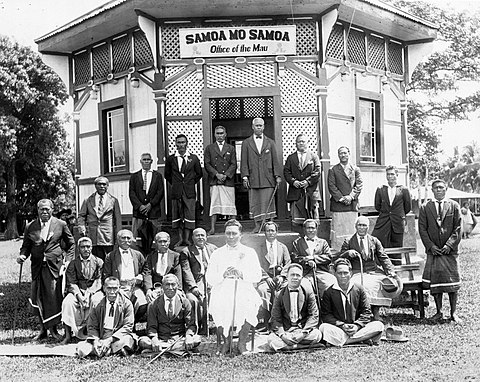
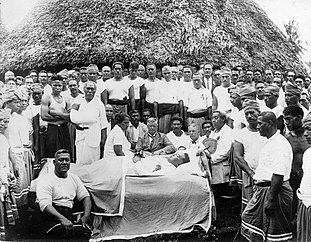
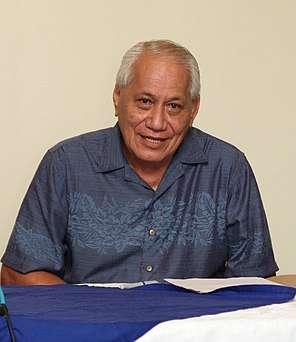
Tupua Fuiavailili was adopted by King Muagututi'a and his wife, Fenunuivao of Falefa and named as the King's successor, leading to the first usage of the term "Tama-a-'aiga" by the orator polity of Leulumoega and Lufilufi (collectively known as Tumua) in reference to his many genealogical connections Tupua had to the great families of Samoa. The Aiga Sā Fenunuivao (Fenunuivao's descendants) from the villages of Falefa and Salani, are the primary political family of the Sā Tupua clan, led by Moeono of Falefa and Tofua'iofoia of Salani. The family holds authority and custodianship of the title and decides who from among its heirs it should be bestowed upon.[3][2]
Royalty: The Tama-a-'aiga & Pāpā Titles
Tama-a-Aiga titles are the maximal lineage titles of Samoa. These titles are often associated with Pāpā titles, paramount district titles which affords the holder authority over an entire region or sovereignty over all of Samoa (if one acquires all four pāpā). The field of contention for the papa titles and tafa'ifa was confined to the leading members of two families, Sa Tupua and Sa Malietoa, under whom all Samoa is united. The leading tides of these two family lineages were called tama'aiga (sons of families). By mid-19th century, the tama-a-aiga Tupua Tamasese of Sa Tupua and Malietoa of Sa Malietoa were joined by two more titles Mata'afa and Tuimaleali'ifano as the four highest titleholders of Samoa. All were descended from Queen Salamasina, the daughter of Tui A'ana Tamalelagi and descedant of the Tu'i Tonga. She became the first sovereign of all Samoa.[4]
Throughout most of Samoa's history, the root cause of civil unrest was the struggle for titular supremacy among these families.The senior of the two, Sa Tupua dominated the office since the late 1500's. Sa Malietoa joined at the beginning of the 19th century, coinciding with the collapse of Manono's dominance and the arrival of British missionaries.[4]
Both the Tama-a-Aiga Tupua Tamasese title and the pāpā Tui Atua mantle are currently held by Samoa's former Prime Minister and Head of State, His Highness Tui Atua Tupua Tamasese Efi.
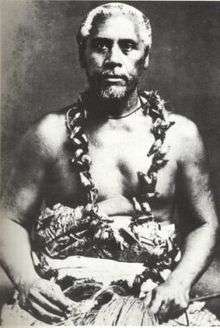
Origins of Tupua Tamasese
The origins of the Tupua (later Tupua Tamasese) title is found in the genealogical line of succession tracing back to the rule of Queen Salamasina. Her descendant, Fonoti, won the civil war that led to his installation as King. His son and successor, Muagututi'a, married Fenunu'ivao, daughter of Leutele of Falefa. Because they had no children of their own, they adopted Fuiavailili, son of Fuimaono of Salani as their son. As the successor of King Muagututi'a, the orators of Tumua - the orator polity of Upolu based in Lufilufi and Leulumoega - questioned who this child was to assume such an important mantle and whether he possessed the necessary genealogical links to the great families of Samoa in order to be worthy. This inquiry is known as when "na saesae laufa'i ai Tumua" (lit. when Tumua systematically 'ripped the leaves of the banana tree' to examine the child's lineage).[2]
- "E tua Mulinu'u ia Falenu'utapu, tatala le lafo o Manuō. E tua Vainiu i Aleipatalemele, tatala le lafo o Molio'o. E tua Vaie'e i Nofopule, tatala le lafo o 'Iuli. E tua Vailiili i Laloaoa, tala le lafo o Moeono. Toe tua Vailiili i Salani ma Olofesula, tatala le lafo o Tofua'iofoa. Tua o Salani ma Olofesula i Falefasa, tatala le lafo o Talolema'agao. Toe tua o Falefasa i Faleniu ma Faletoi i Saoluafata, tatala le lafo o Faautagia. One faapea loa Tumua, o le tama e tele ona aiga, o le Tama a Aiga."
Through this careful process, it was revealed that Fuiavailili's biological father Fuimaono was a direct descendant of Queen Salamasina's second child, Tapumanaia.[5] Through his ancestry and adoption, Tupua Fuiavailili re-united the Salamasina lineages through his biological ancestor, Tapumanaia, and King Muagututi'a's ancestor Fofoaivao'ese, Salamasina's first child. Having satisfied the requirements of having strong linkages to Samoa's royal lineages and noble families, Tupua Fuiavailili was proclaimed as the first Tama a 'Āiga (lit.'child of the families') by the orators of Tumua and succeeded his adoptive father as the next King.[6]
Queen Salamasina to King Tupua I: Reuniting the Royal Bloodlines
Samoa's first ruler to possess all four pāpā titles and therefore become Queen was Salamasina, daughter of Vaetofaga (a granddaughter of the Tu'i Tonga Kau'ulufonua II) and the Tui A'ana Tamaalelagi. She was entrusted to the care of Levalasi So'oa'emalelagi, wife of the Tui Atua Māta'utia. She was betrothed to marry Tonumaipe'a Tapumanaia in order to form a political alliance with the influential Tonumaipe'a faction in Savai'i. Salamasina instead, eloped with her love, Alapepe. This relationship brought forth a daughter named Fofoaivaoese, who grew to become Tuia‘ana and the ancestress of several prominent Samoan families.[7]
Alapepe, however, was pursued by the furious Tonumaipe‘a clan to the Tongan island of Tongatapu where he was killed for “defiling” the taupou. Salamāsina's son by Tapumanaia was named after his father and later received the Lesātele title of the Salani and Sālesātele villages in Falealili, thereafter known as Tapusatele.[7]
In a twist of fate, the lines of both Fofoaivaoese and Tapusatele - Salamasina's heirs - were reunited by Tupua Fuiavailili, the first Tama-a-'Aiga. Tupua's biological father, Fuimaono, was a direct descendant of Tapusatele. His adoptive father, King Muagututi'a, was a direct descendant of Fofoaivaoese. Tupua Fuiavailili was thus the first King to be descended from Queen Salamasina through both her children, Fofoaivaoese and Tapusatele. The young untitled men of Falefa have thereafter been called Tupua ma le Aumaga (literally "Tupua and the young men"), marking the arrival of Tupua Fuiavailili to Falefa and his status as the young heir of King Muagututi'a, which would also have entailed duties as leader of the young untitled men. To this day, these young men stand guard at every bestowal ceremony and are responsible for guarding the chiefs of Falefa and the holder of the Tupua Tamasese title.
Fofoaivaoese, to Tupua
- Queen Salamāsina (progenitor of Samoa's four main royal bloodlines)
- Queen Fofoaivaoese (first daughter of Queen Salamasina)
- Queen Taufau Asiata (daughter of Queen Fofoaivaoese)
- King Faumuinā (nephew of Queen Taufau)
- King Fonoti (Defeats siblings for Kingship; Falefa is rewarded and named as Fonoti's capital during this time.)
- King Muagututi'a. (marries Fenunuivao, daughter of Leutele, of Falefa.)
- No children. *Fuiavailili is brought to Falefa and named heir to King Muagututi'a, Tupua Fuiavailili
- King Tupua Fuiavailili (the first Tupua and the first 'Tama-a-'aiga)
Tapusātele, to Tupua
- Queen Salamāsina (progenitor of Samoa's four main royal bloodlines)
- Tapumanaia Tapusatele (marries Sailau Fenunuivao, daughter of Leutele, of Falefa.)
- Sifuiva
- Fuimaono
- Fuiavailili
- Taken to Falefa and named, Tupua Fuiavailili. Becomes Tafa'ifā (King) Tupua Fuiavailili (the first Tupua' and the first Tama-a-'aiga)
Tupua's Aloali'i (Heirs apparent)
Tupua would go on to sire children through different unions, all politically important to cement his reign. From his four usuga (marriages), King Tupua Fuiavailili had five children:
- Afoa (later named Afoafouvale, after his defeat in battle), of Palauli.
- Galumalemana, of Saleimoa (who later succeeded his brother Afoa as King by defeating him at Maauga, Leulumoega). Named after Galu and Mana and signifies the A'ana connection of later Tupua Tamasese. There are many holders of the current title.
- Luafalemana, of Falefā. The only aloalii that is part of Aiga Sa Fenunuivao and also the ancestor of the Matā'afa Tama-a-Aiga line. The residence of Luafalemana remains at Falefa. There are no current holders of the title.
- Tautisusua and Tufugatasi.
Appointment
When a Tupua is to be appointed, the two senior members of Aiga' Sa Fenunu'ivao (Tofua'iofoia of Salani and Moeono of Falefa) summon the descendants of Fenunu'ivao (mother of the first Tupua) to decide on who should hold the mantle.[2]
The current holder, His Highness Tui Atua Tupua Tamasese Efi, is thus a direct descendant of Fenunu'ivao, Tupua Fuiavalili and his grandson, Nofoasaefā, of Asau, Savaii. Tupuola Efi was chosen as Tupua Tamasese by Aiga Sa Fenunu'ivao after the passing of his uncle, former Prime Minister Tupua Tamasese Lealofi IV.[2]
Moeono and Tofua'iofoia speak for Aiga Sa Fenunu'ivao, not only on matters pertaining to the Tupua title, but also on dealings with Samoa's other main political families, such as Sa Tuala and Sa Levalasi. Tofua'iofoia and Moeono are members of the great council of Atua which meets at Lalogafu'afu'a, the meeting place of Atua's leaders in Lufilufi.[2]
Notable Holders
- King Tupua Fuiavailili was the first of the Tupua and became King of Samoa in c.1550, succeeding his father King Muagututi'a, son of King Fonoti. He is the first descendant of Queen Salamasina to have brought together the royal lines of both her children - Queen Fofoaivaoese and Tapumanaia.[2]
- Tui Atua Tupua Tamasese Titimaea is the first time the Tamasese name appears alongside the tama-a-aiga Tupua title. Because of his prowess in war and popularity among the orators of Tumua, he was conferred the Tupua title. Among these qualities, he was known to be hospitable and generous (tama gāsese mea lelei), and the name Tamasese was derived from this appellation by which Titimaea and his descendants have been known ever since.[2]
- Tupua Tamasese Lealofi III was the leader of the Mau Movement until his assassination by NZ armed forces during the Black Saturday massacre in 1929. Realizing that his death could spark a bloody war with NZ colonial forces, Tamasese called for peace and for the Mau to continue on with its passive resistance and civil disobedience. His final words were “My blood has been spilt for Samoa. I am proud to give it. Do not dream of avenging it, as it was spilt for peace."[8]
- Tupua Tamasese Meaʻole - Samoa's co-head of state at the time of the country's independence in 1962 - served as Tupua Tamasese from 1929 until his death in 1963. Mea'ole was succeeded as Tupua Tamasese by his younger brother,
- Tui Atua Tupua Tamasese Lealofi IV (1922–1983). Younger brother of Tupua Tamasese Mea'ole and elected 2nd Prime Minister of Samoa. Later ascended to the Council of Deputies.
- Tui Atua Tupua Tamasese Efi formerly served as the 3rd Prime Minister of Samoa. He was selected by Aiga Sa Fenunu'ivao to succeed his uncle, Tupua Tamasese Lealofi IV in 1984. He was sworn in as Samoa's O le Ao o le Malo (Head of State) on June 16, 2007 until 2017 when the sitting Prime Minister and long-time rival of Tupua, Tuilaepa Sailele Malielegaoi, refused to endorse him for a third term. He is now a patron of the arts, culture and history and a celebrated scholar of Samoa.
Succession List: From Queen Salamasina to Tui Atua Tupua Tamasese Efi
Salamasina's Daughter, Fofoaivaoese, to Tupua
Tafa'ifā Queen Salamāsina (progenitor of Samoa's four main royal bloodlines)
Tafa'ifā Queen Fofoaivaoese (first daughter of Queen Salamasina)
Tafa'ifā Queen Taufau Asiata (daughter of Queen Fofoaivaoese)
Le Tupufia (The King with only three pāpā) Faumuinā (nephew of Queen Taufau)
Tafa'ifā King Fonoti (Defeats siblings for Kingship; Falefa is rewarded and named as Fonoti's capital during this time.)
Tafa'ifā King Muagututi'a. (marries Fenunuivao, daughter of Leutele, of Falefa.)
- King Muagututi'a and Fenunuivao bear no children. Fuiavailili is brought to Falefa and named heir to King Muagututi'a. Given the name Tupua Fuiavailili by Moeono, tulafale alii and matua of Falefa.
Tafa'ifā King Tupua Fuiavailili (the first Tupua and the first 'Tama-a-'aiga)
Salamasina's Son, Tapumanaia II (Tapusatele), to Tupua
Tafa'ifā Queen Salamāsina (progenitor of Samoa's four main royal bloodlines)
Tapumanaia (taken to Falealili and renamed Tapusatele; marries Sailau, daughter of Leutele, of Falefa.)
Tapufautua
Sifuiva
Fuimaono (marries Oilau, of Faleālili.)
Fuiavailili
- *Fuiavailili is taken to Falefa and named, Tupua Fuiavailili.
Tafa'ifā King Tupua Fuiavailili (the first Tupua and the first 'Tama-a-'aiga)
King (Tafa'ifā) Tupua Fuiavailili to Tui Atua Tupua Tamasese Efi
King Tupua Fuiavailili, descendant of Queen Salamasina, adopted son of King Muagututi'a and Fenunuivao, daughter of Leutele
King Afoa (defeated in single combat by his brother, Galumalemana. Thereafter named Afoafouvale, "he who rebels for no good reason.")
King Galumalemana (the Aloalii as an institution of succession is established under Galumalemana)
King Nofoasaefā (tyrant, assassinated by rebels in Savai'i)
King I'amafana (allegedly willed his kingdom to Malietoa Vainuupo; succeeded by Safeofafine but was killed in combat; kingship passes to Tamafaigā)
1751 - 1830: Maeaeafe Mataafa
1830 - 1860: Tupua Moegagogo
1860s - 1891: Tui Aana Tui Atua Tupua Tamasese Titimaea (this is the first time Tamasese is used together with the Tupua title)
1891 - 1915: Tupua Tamasese Lealofi-o-a'ana I, son of Tupua Tamasese Titimaea.
1915 - 1918: Tupua Tamasese Lealofi-o-a'ana II, eldest son of Tupua Tamasese Lealofi-o-a'ana I
1918 - 1929: Tupua Tamasese Lealofi-o'a'ana III (Mau leader, assassinated by NZ Soldiers during Black Saturday), younger brother of Tupua Tamasese Lealofi-o-a'ana II
1929 - 1963: Tupua Tamasese Mea'ole (Co-Head of State with Malietoa Tanumafili II after Independence), younger brother of Tupua Tamasese Lealofi-o-a'ana III
1963 - 1983: Tui Atua Tupua Tamasese Lealofi-o-a'ana IV (this is the first time Tamasese is formalised as part of the Tupua title) - Third Prime Minister of Samoa, son of Tupua Tamasese Lealofi-o-a'ana III
1986–present: Tui Atua Tupua Tamasese Efi (Former Prime Minister and Head of State 2007-2017), son of Tupua Tamasese Mea'ole.
See also
| Wikimedia Commons has media related to Tupua Tamasese. |
- Fa'amatai, chieflty system of Samoa.
- Malietoa
- Mata'afa
- Tuimaleali'ifano
- Tui Manu'a
References
- "Malietoa Tanumafili II (Obituary)". The Economist. The Economist print edition. 2007-05-24. Retrieved 2007-06-12.
- Soʻo, Asofou. (2008). Democracy and custom in Sāmoa : an uneasy alliance. IPS Publications, University of the South Pacific. ISBN 978-982-02-0390-7. OCLC 244005120.
- LC2440, 29 March 1965. The court ruled that the pule of the Tupua title...is vested in the family of Sā Fenunuivao of Falefā and Salani.
- Tuimaleali'ifano, Morgan (June 1998). "Titular disputes and national leadership in Samoa". The Journal of Pacific History. 33 (1): 91–103. doi:10.1080/00223349808572860. ISSN 0022-3344.
- Tamasese Efi, Tui Atua Tupua (1995). ""Tamafaigā — shaman, king or maniac?"". The Journal of Pacific History. 30: 3–21.
- Suaalii-Sauni, Tamasailau M. (2018). Su'esu'e Manogi: Tui Atua Tupua Tamasese Ta'isi and the Samoan Indigenous Reference. Huia (NZ) Ltd. ISBN 978-1-77550-359-0. OCLC 1065077940.
- Tavale, Tofaeono Tanuvasa (2012). Foafoago O Samoa. New Zealand: Fuelavelave Press.
- Field, Michael J. (1991). Mau : Samoa's struggle for freedom. Polynesian Press. ISBN 0-908597-07-X. OCLC 468531148.